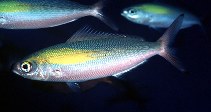| Family: |
Caesionidae (Fusiliers), subfamily: Caesioninae |
| Max. size: |
25 cm TL (male/unsexed) |
| Environment: |
reef-associated; marine; depth range 1 - 30 m, non-migratory |
| Distribution: |
Indo-West Pacific: Andaman Sea to the Philippines. |
| Diagnosis: |
Dorsal spines (total): 10-10; Dorsal soft rays (total): 14-16; Anal spines: 3-3; Anal soft rays: 12-12. Body blue-green to reddish dorsally, lighter ventrally; above pectoral fin is a large yellow blotch of variable size, roughly rhomboid in shape, the oblique side slanting anteriorly. 4 scales on cheek; 22-27 predorsal scales; scaled dorsal and anal fins; Upper peduncular scale rows usually 11-13 (11-14); lower peduncular scale rows usually 15 or 16 (15-17). Supra-temporal band of scales confluent at dorsal midline. basioccipital with a broad, flat process for attachment of Baudelot's ligament; processes not extending much more ventrally than rim of condyle. Post maxillary with 2 processes; posterior end of maxilla tapered (Ref. 1723). Head length 3.3-3.6 in SL; body depth 3.4-4.9 in SL (Ref. 90102). |
| Biology: |
Ranges widely around coral reefs in school. Feeds on zooplankton in midwater aggregations. Oviparous, with numerous, small pelagic eggs (Ref. 402). Easily recognized from a distance by the bright yellow marking (Ref. 48636). Also caught by drive-in nets. |
| IUCN Red List Status: |
Not Evaluated (N.E.) Ref. (130435)
|
| Threat to humans: |
harmless |
Source and more info: www.fishbase.org. For personal, classroom, and other internal use only. Not for publication.

